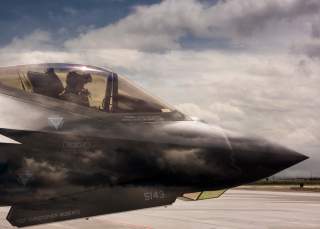Flak Cannons Could Pose A Huge Threat To The F-35
It's not only high-tech threats that pose a problem.
Key point: Ground fire still poses a threat to U.S. aircraft—no matter how advanced.
Surface-to-air missiles—those high-tech killers of aircraft—tend to get all the attention. But the U.S. Air Force reminds us that old-fashioned anti-aircraft guns are still a threat.
Hence the genesis of a new Air Force research project to locate flak batteries in the same way that ground troops use technology to identify the location of mortars and snipers. The goal of the project, titled "Target ID of Radar Backtracking of Ant-Aircraft Projectiles," is to use airborne radar to trace the trajectory of anti-aircraft shells back to their source.
Significantly, while the text of the research solicitation doesn't mention the F-35, the acquisition program that the project is intended is listed as the F-35 Joint Strike Fighter. In addition, the F-22 is included in the list of keywords at the bottom of the solicitation.
"I'm sure it isn't a coincidence," says Dan Grazier at defense watchdog Project on Government Oversight. "The F-35 is quite vulnerable to ground fire, especially since the designers decided not to include self-sealing fuel tanks."
It's not just the F-35. The flak future awaiting the F-35 and other U.S. aircraft appears to be a grim one, according to the Air Force. "Legacy AAAs [anti-aircraft artillery] are already lethal to 35,000 feet and will become more lethal as projectiles become smarter and as radar tracking improves. In the near future, they will be more lethal at much higher attitudes as numerous hyper-velocity technologies come online such as railguns and extended range artillery with smart seeker shells come online."
Pilots tend to discover the presence of flak only when shells start bursting around them. Even then, camouflaged anti-aircraft guns can be hard to spot, making flak suppression difficult. Yet anti-aircraft guns have distinctive characteristics that the Air Force hopes to exploit. For example, anti-aircraft can only be emplaced in certain types of terrain. More importantly, "most AAAs have multiple gun barrels in close proximity which provide a distinct multi-path return," the Air Force points out. "The radar cross-section of the AAA cannon barrels will have distinctively different signatures from resonant and non-resonant frequencies when scanned with multiple frequencies. Also, the scintillation characteristics of these barrel will be very distinctive especially if the AAA has an armored plate or a radar associated with it. "
Fortunately, the Air Force will get a head start on flak-tracking thanks to the ground troops. "Similar techniques already exist for counterbattery artillery and mortar shell tracking systems from U.S. Army ground-based radars," the Air Force notes.
The first phase of the project will involve surveying common anti-aircraft guns and their radar cross-sections. That information will be matched with various U.S. airborne radars. Interestingly, the solicitation specifically mentions radar carried by AC-130 gunships, as well as X-band weather radars, as potential flak detectors.
Some experts question whether the Air Force should even be putting its aircraft in harm's way. "The interesting thing to me is they still think in terms of sending the delivery vehicle, whether manned or unmanned, into contested air space," Grazier says. "With all the discussion of standoff weapons, AAA shouldn't be that much of a concern anymore."
On the other hand, there are times when the troops on the ground are in trouble and standoff missiles aren't available or can't be used. Fighters such as the F-16 and F/A-18 have occasionally swooped low in Afghanistan to use their cannon on low-level strafing runs (the sort of mission for which the A-10 Warthog has become a legend). Then there are transport aircraft and helicopters whose missions make them vulnerable to ground fire, as are all aircraft during takeoff and landing.
As long as flak remains a threat, there will a need to locate and suppress it.
Michael Peck is a contributing writer for the National Interest. He can be found on Twitter and Facebook. This first appeared in May 2018.
Image: DVIDS.

